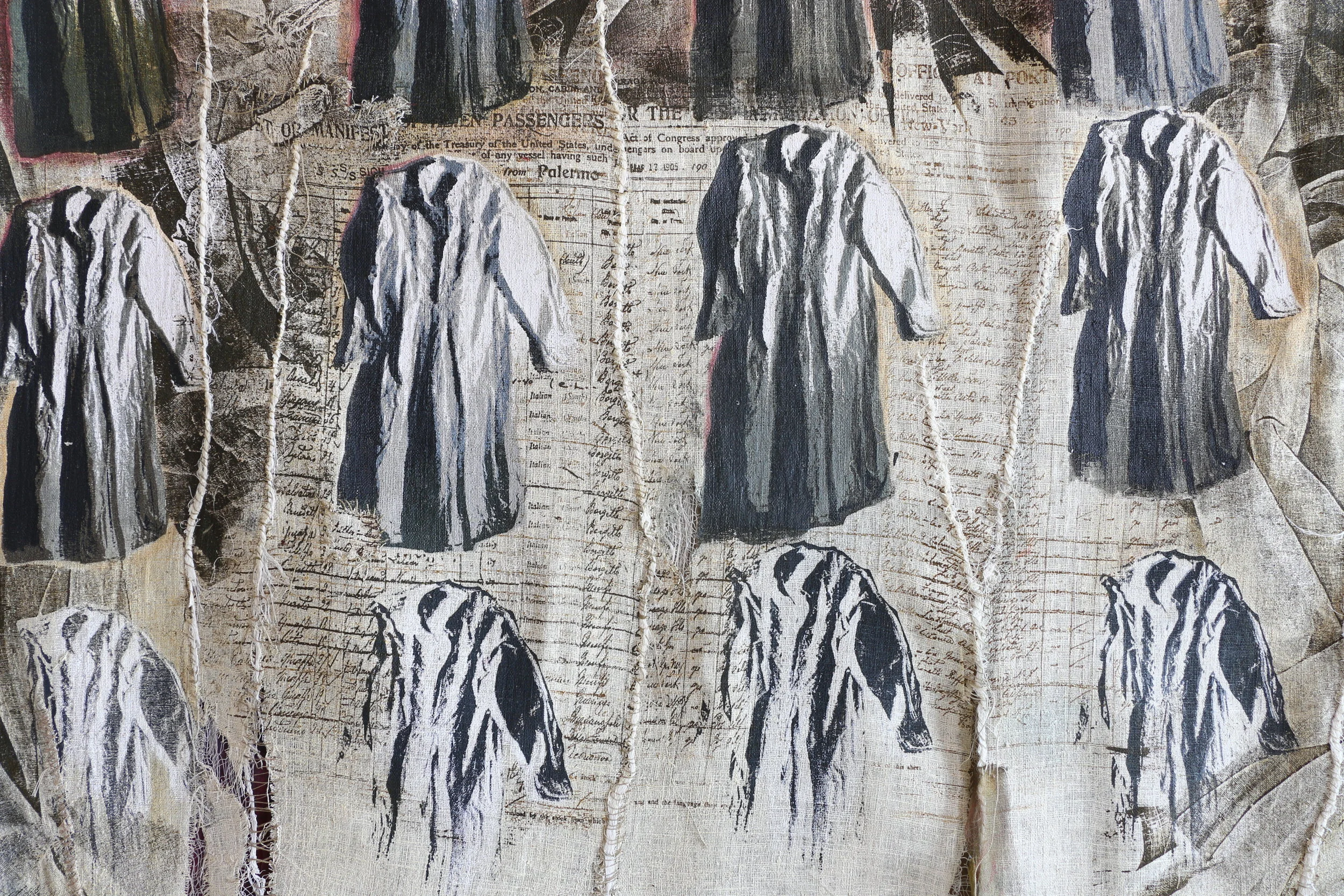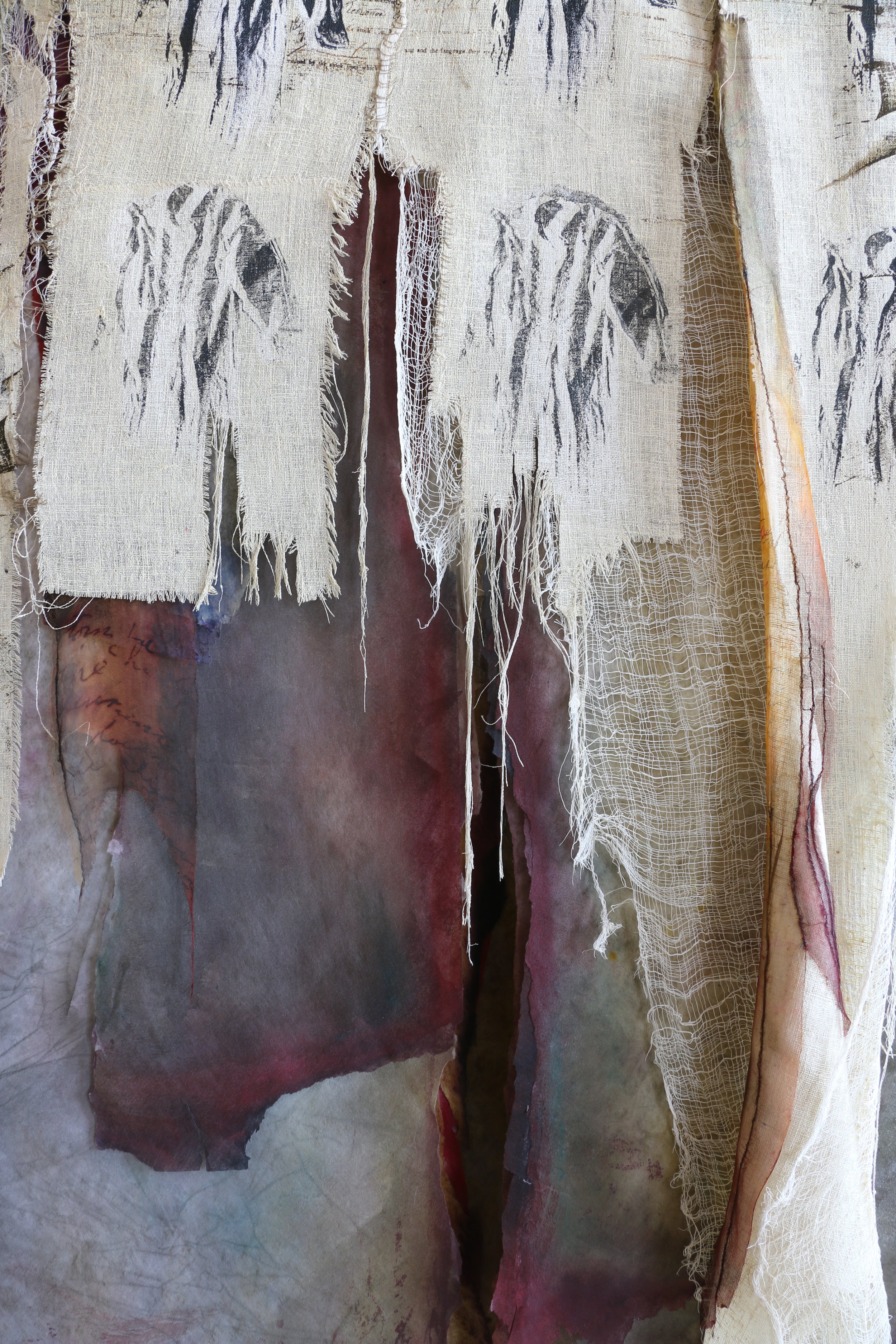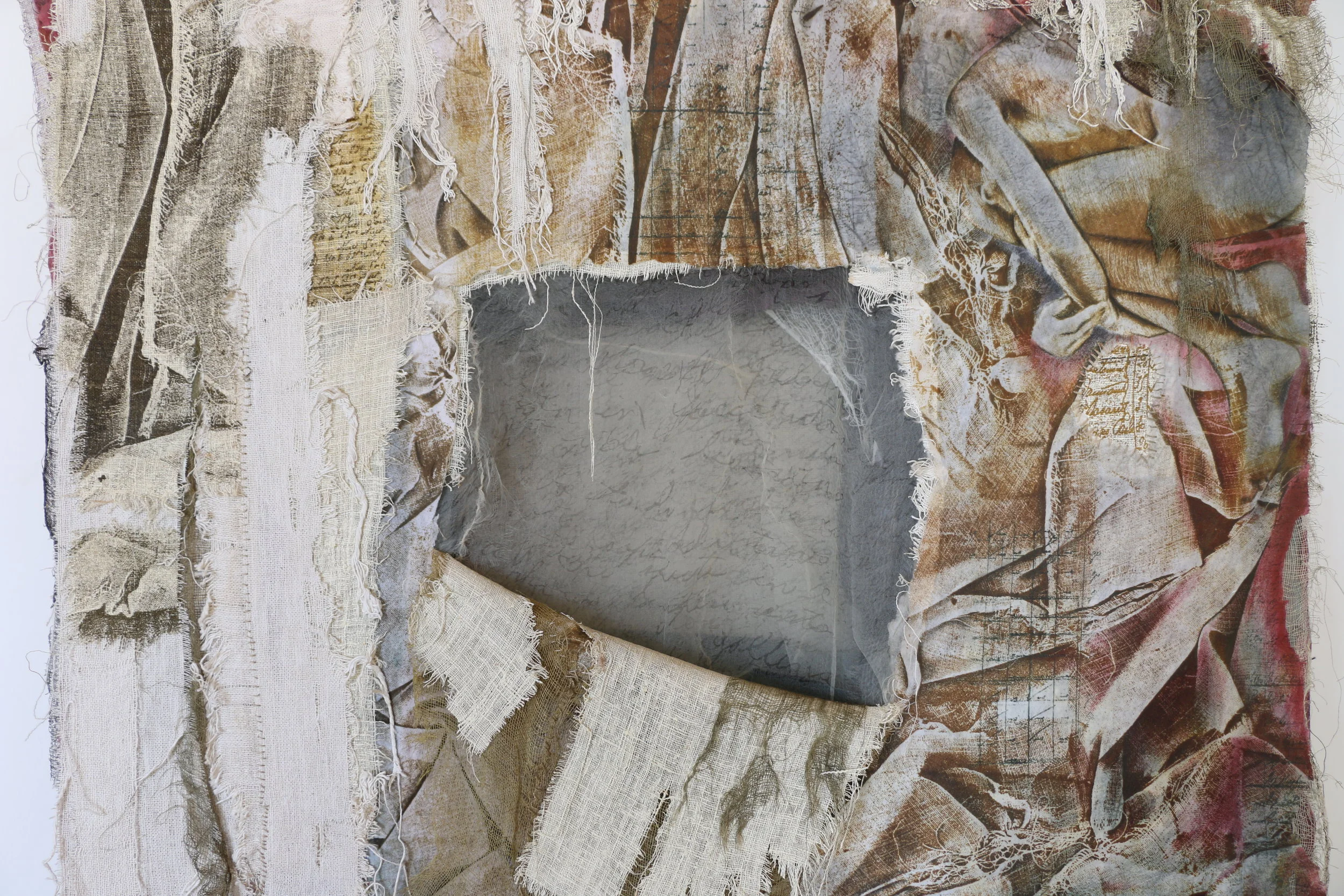



































Your Custom Text Here
Preservation carries messages about value and rarity. I am curious about that which survives or endures the passage of time, whether by chance or by deliberate and careful conservation. Preserving both the tangible (objects which have been saved) as well as the intangible (storytelling, beliefs, human experiences) is a theme in much of my early work. Objects or images with seemingly little intrinsic value that are presented or stored with reverence and care question our motives of preservation. My work also implies that the ordinary can be transformed and deemed worthy of keeping.
The intimacy I seek in my pieces depends on engaging the viewer with transformation of surface and materials. Touching, fabricating and shaping fiber is an exciting and compelling process for me, not just a means to an end. I love to take cloth and push it; make it shrink, then expand; become raised up, then recede; become sheer, then opaque. It is a challenge for me to create contrasts, a surface energy or tension that the viewer can sense. Above all, I work the cloth until it bears the humanness – the importance of human touch. It must breathe the hand of the maker.
I have always been interested in language and oral traditions of storytelling. Listening to and recording stories from elderly members of my own family has fueled the content of much of my work from 1990-2000. I was interested in exploring why certain memories, stories and beliefs survive and are revealed and renewed through time. The text imagery is taken from writings of those who have recorded personal accounts, proverbs, or life experiences. The handwriting is photographically transferred by silkscreen so that it retains all of the original character. Early on, I printed text with pigment or dye. Later, I began silkscreening with a mild acid that etches or burns the original handwriting into the surface of the cloth, integrating it permanently with the structure. It is not so important that words are able to be read; rather, that they connote communication beyond what is actually written – perhaps an audible memory of the sound of a voice.
I embrace the idea of “old but kept” cloth as a metaphorical expression of people’s lives. Clearly, cloth can be physical evidence of past experiences and rituals. Fabric that has been handled, washed, ironed and folded repeatedly possesses a quality evocative of human care. Thus, the cloth is, at times, not only the form, but the subject matter – cloth and clothing as manifestations of the lives which possessed them.
I have been given some pieces of linen, which were handwoven over 100 years ago by my great grandmother. I keep them wrapped up carefully in a box in a drawer. I feel a certain responsibility to save these remnants, not because of their intrinsic value, but because someone else had preserved them all those years before me. Time goes by, and I may never look in that box, yet I know it’s there. That which is carefully wrapped, protected, and put away for another time has value even if never touched or looked at again. Just our awareness of its existence is enough reason to save it. My work tries to affirm the need to keep safe that which cannot be touched.
The most precious objects that I own are handwritten letters from family and friends that I have accumulated over many years. In a time when handwritten letters are becoming scarce, I wanted to build a safe space. I began wrapping and stitching string, gauze and sheer silk around stacks of letters. This idea led to the piece Chrysalid. The title alludes to the impending emergence of a cocoon. The partially concealed, bundled forms speak about suspended time, and our need to preserve the intangible things that we hold close.
In my Excavation and Soulskin series, I present cloth and clothing as having the same significance as other essential elements of the earth. In this way, I want to elevate the value of cloth as personal evidence of a life. Some of my Soulskin pieces are quite fragile. I love the vulnerability that cloth shares with skin.
With the new millennium my work continues to explore the theme of preservation, yet now it is concerned with preservation of the land. This past year, I purchased some acreage outside the city. I have spent many days and nights immersed in an environment of woods, streams, meadows and lake. I am gradually reintroducing the native prairie grasses and making efforts to preserve and nurture the wild life. Time and process take on new meanings – “readings” of tree skeletons, tracks in the mud, intricate nest weavings, thousands of opening seed heads, and the indefatigable patience of the heron – these are now becoming my text. This new venture has had a profound impact on my work. The excitement of a change in surroundings and the daily observance of decay, rebirth, and survival in the wild have opened up unlimited possibilities.
Susan Lordi Marker
Preservation carries messages about value and rarity. I am curious about that which survives or endures the passage of time, whether by chance or by deliberate and careful conservation. Preserving both the tangible (objects which have been saved) as well as the intangible (storytelling, beliefs, human experiences) is a theme in much of my early work. Objects or images with seemingly little intrinsic value that are presented or stored with reverence and care question our motives of preservation. My work also implies that the ordinary can be transformed and deemed worthy of keeping.
The intimacy I seek in my pieces depends on engaging the viewer with transformation of surface and materials. Touching, fabricating and shaping fiber is an exciting and compelling process for me, not just a means to an end. I love to take cloth and push it; make it shrink, then expand; become raised up, then recede; become sheer, then opaque. It is a challenge for me to create contrasts, a surface energy or tension that the viewer can sense. Above all, I work the cloth until it bears the humanness – the importance of human touch. It must breathe the hand of the maker.
I have always been interested in language and oral traditions of storytelling. Listening to and recording stories from elderly members of my own family has fueled the content of much of my work from 1990-2000. I was interested in exploring why certain memories, stories and beliefs survive and are revealed and renewed through time. The text imagery is taken from writings of those who have recorded personal accounts, proverbs, or life experiences. The handwriting is photographically transferred by silkscreen so that it retains all of the original character. Early on, I printed text with pigment or dye. Later, I began silkscreening with a mild acid that etches or burns the original handwriting into the surface of the cloth, integrating it permanently with the structure. It is not so important that words are able to be read; rather, that they connote communication beyond what is actually written – perhaps an audible memory of the sound of a voice.
I embrace the idea of “old but kept” cloth as a metaphorical expression of people’s lives. Clearly, cloth can be physical evidence of past experiences and rituals. Fabric that has been handled, washed, ironed and folded repeatedly possesses a quality evocative of human care. Thus, the cloth is, at times, not only the form, but the subject matter – cloth and clothing as manifestations of the lives which possessed them.
I have been given some pieces of linen, which were handwoven over 100 years ago by my great grandmother. I keep them wrapped up carefully in a box in a drawer. I feel a certain responsibility to save these remnants, not because of their intrinsic value, but because someone else had preserved them all those years before me. Time goes by, and I may never look in that box, yet I know it’s there. That which is carefully wrapped, protected, and put away for another time has value even if never touched or looked at again. Just our awareness of its existence is enough reason to save it. My work tries to affirm the need to keep safe that which cannot be touched.
The most precious objects that I own are handwritten letters from family and friends that I have accumulated over many years. In a time when handwritten letters are becoming scarce, I wanted to build a safe space. I began wrapping and stitching string, gauze and sheer silk around stacks of letters. This idea led to the piece Chrysalid. The title alludes to the impending emergence of a cocoon. The partially concealed, bundled forms speak about suspended time, and our need to preserve the intangible things that we hold close.
In my Excavation and Soulskin series, I present cloth and clothing as having the same significance as other essential elements of the earth. In this way, I want to elevate the value of cloth as personal evidence of a life. Some of my Soulskin pieces are quite fragile. I love the vulnerability that cloth shares with skin.
With the new millennium my work continues to explore the theme of preservation, yet now it is concerned with preservation of the land. This past year, I purchased some acreage outside the city. I have spent many days and nights immersed in an environment of woods, streams, meadows and lake. I am gradually reintroducing the native prairie grasses and making efforts to preserve and nurture the wild life. Time and process take on new meanings – “readings” of tree skeletons, tracks in the mud, intricate nest weavings, thousands of opening seed heads, and the indefatigable patience of the heron – these are now becoming my text. This new venture has had a profound impact on my work. The excitement of a change in surroundings and the daily observance of decay, rebirth, and survival in the wild have opened up unlimited possibilities.
Susan Lordi Marker
Chrysalid
cotton, synthetic fiber, paper, pigment, thread
24" x 32" x 9". 1993
Chrysalid DETAIL
Chrysalid DETAIL
Old Stories
silk, rayon, dye, pigment, thread, wood
72" x 18" x 6"
1991
Soulskin; Listening to Julia
linen, silk, cotton, thread, dye
29" x 26"
1995
Soulskin; Listening to Julia DETAIL
Excavation: Soulskin #11
linen blend, thread, dye, pigment / devoré
66" x 34"
Excavation: Soulskin #11 DETAIL
Manifesto
Cotton, nylon, dye, pigment, thread
65" x 65" x 5"
1993
Manifesto DETAIL
Manifesto DETAIL
Manifesto DETAIL
Tree
Collage
11" x 7.5". 1992
Book of Experiments
Mixed media
24" x 22" x 3". 1992-97
“Lordi Marker’s handmade ‘book’ of experiments is especially intriguing. Swatches of materials, images of various sorts, are stitched together as if they were fragments of dreams, complex and multi-layered as dreams are. The pieces in this book sometimes precede, but often accompany the development of ongoing work. In this gathering of samples are ideas and images that will occur in finished work. Even the most spontaneous-seeming of Lordi Marker’s early and later pieces may have undergone arduous rehearsal, possibly in more than one medium. The book of experiments is, in a very real sense, the artist’s visual diary”
Book of Experiments DETAIL
Excavation: Soulskin #10
linen blend, thread, dye, pigment / devoré
30" x 47" X 13". 1997
“I embrace the idea of “old but kept” cloth as a metaphorical expression of people’s lives. Clearly, cloth can be physical evidence of past experiences, traditions, and rituals. The text which is burnt through the surface alludes to a personal account, traditions of storytelling, or proverbs passed down through generations, These are all intangibles which can slip through one’s fingers if they are not somehow preserved, Both skin and cloth are fragile and vulnerable to the elements, and I question what really lasts, or endures through time.“
Excavation: Soulskin #10 DETAIL
Lost Dialect DETAIL
Silk gauze, dye, thread
DETAIL (overall piece is 72" x 18" x 6"). 1991
Keeper of the Records
silk, cotton, synthetic fiber, pigment, thread
72" x 43" x 6". 1992
“Much of my work refers to documents, books or diaries, yet at the same time suggesting communication beyond the written word. Who or what is the true ‘keeper of the records? How do we preserve the intangible? The forms I use could also carry metaphorical messages about preservation, preciousness, and rarity.”
Keeper of the Records DETAIL
Keeper of the Records DETAIL
Keeper of the Records DETAIL
Keeper of the Records DETAIL
Sympathetic Resonance
cotton, silk, nylon, synthetic fiber, pigment, thread
42" x 29" x 6". 1992
Sympathetic Resonance DETAIL
Sympathetic Resonance DETAIL
Tell Your Own Story
cotton, silk, nylon, synthetic fiber, pigment, thread
42" x 29" x 6". 1992
Tell Your Own Story DETAIL
Passageways, Passageways—Anatomy of an Heirloom
synthetic fiber, cotton, pigment, thread
30" x 53" x 5". 1993
Passageways, Passageways—Anatomy of an Heirloom DETAIL
Passageways, Passageways—Anatomy of an Heirloom DETAIL
Damiana’s Cloth
rayon, silk, thread
22" x 25" x 2.5". 1991
Sicilian Socks—The Sacred and Profane
rayon, synthetic fiber, pigment, dye, wood
63" x 80" x 3". 1992
“Tangible objects which are physical evidence of people’s lives are also metaphors for their life experiences and traditions.”
Sicilian Socks—The Sacred and Profane DETAIL
Untapped
cotton, wood, rope, pigment, thread
30" x 33" x 8". 1993
Untapped DETAIL